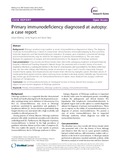Primary immunodeficiency diagnosed at autopsy: a case report.

View/
Date
2014-07-04Author
Walong, E
Rogena, E
Sabai, D.
Language
enMetadata
Show full item recordAbstract
BACKGROUND:
DiGeorge syndrome may manifest as severe immunodeficiency diagnosed at infancy. The diagnosis of primary immunodeficiency is based on characteristic clinical features, immunophenotyping by flow cytometry, molecular diagnostics and functional lymphocyte evaluation. At autopsy, gross evaluation, conventional histology and immunohistochemistry may be useful for the diagnosis of primary immunodeficiency. This case report illustrates the application of autopsy and immunohistochemistry in the diagnosis of DiGeorge syndrome.
CASE PRESENTATION:
A four-month-old African female infant died while undergoing treatment at Kenyatta National Hospital, a Referral and Teaching Hospital in Nairobi, Kenya. She presented with a month's history of recurrent respiratory infections, a subsequent decline in the level of consciousness and succumbed to her illness within four days. Her two older siblings died following similar circumstances at ages 3 and 5 months respectively. Autopsy revealed thymic aplasia, bronchopneumonia and invasive brain infection by Aspergillus species. Microbial cultures of cerebrospinal fluid, jejunal contents, spleen and lung tissue revealed multi drug resistant Klebsiella spp, Pseudomonas spp, Serratia spp and Escherichia coli. Immunohistochemistry of splenic tissue obtained from autopsy confirmed reduction of T lymphocytes.
CONCLUSION:
Use of immunohistochemistry on histological sections of tissues derived from autopsy is a useful adjunct for post mortem diagnosis of DiGeorge syndrome.
Citation
BMC Res Notes. 2014 Jul 4;7(1):425.Publisher
University of Nairobi
Collections
- Faculty of Health Sciences (FHS) [10387]
